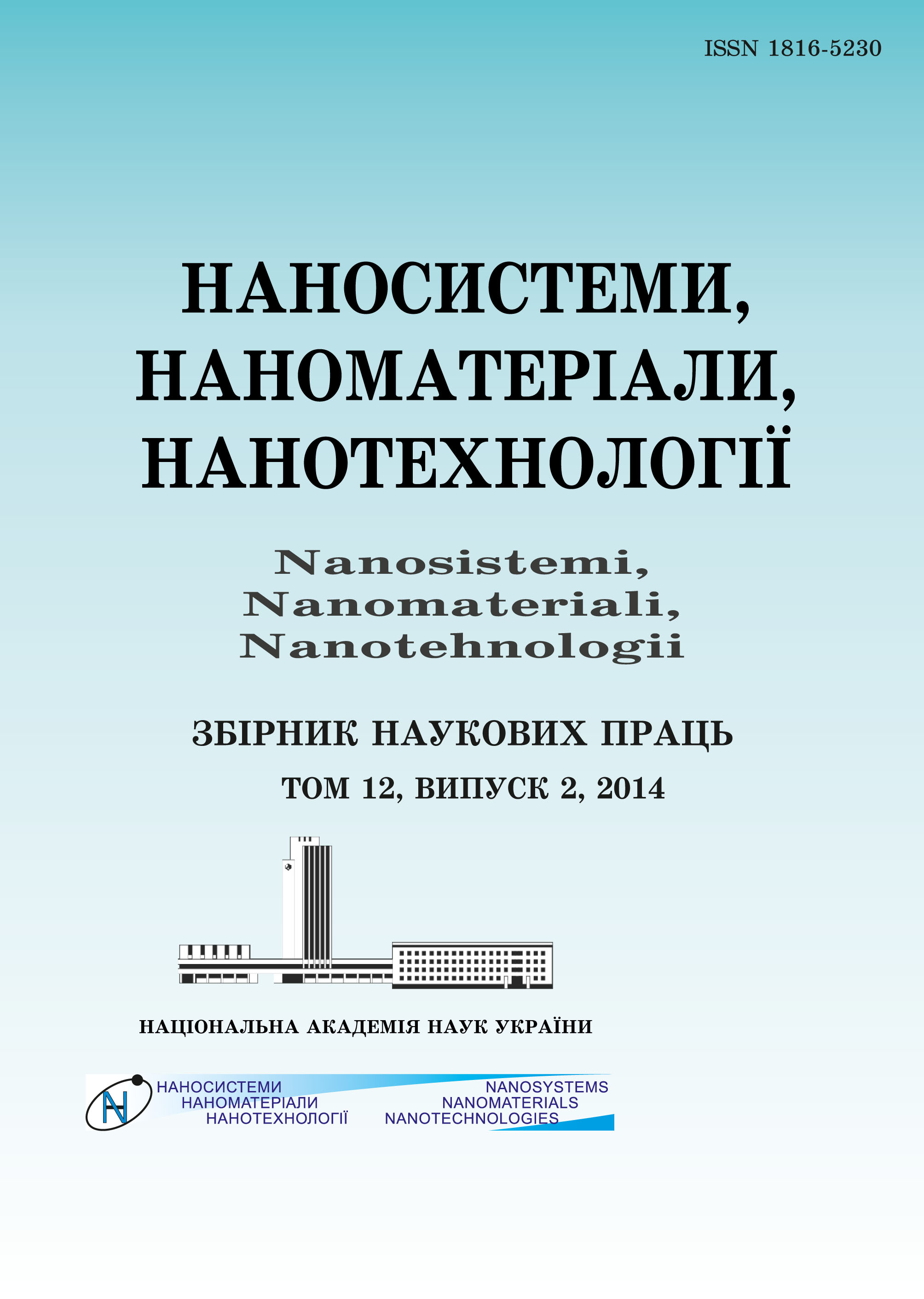|
|
|||||||||
 |
Year 2023 Volume 21, Issue 3 |
|
|||||||
|
|||||||||
Issues/2023/vol. 21 /Issue 3 |
M. A. ZABOLOTNY, L. I. ASLAMOVA, E. M. BOBOSHKO, D. O. HRYNKO, A. A. KOLESNICHENKO, D. S. LEONOV, R. V. LYTVYN, M. M. PETRYSHYN, N. V. MINITSKA, and M. Yu. BARABASH
Modelling of the Electrostatic Image in Films of Photosensitive Amorphous Molecular Semiconductors
477–493 (2023)
PACS numbers: 42.40.Ht, 42.50.Wk, 65.60.+a, 68.35.bj, 78.20.Nv, 85.60.Bt
Creation of nanoscale materials, in particular, the organization of the processes of ordering of the nanoobjects using templates, is one of the main directions of physical materials science and modern-nanotechnologies’ development. The template is a tool for organizing of the physical and chemical processes of structuring of nanoobjects in space and time on its surface due to the near-field interaction. The formation mechanisms of hidden electrostatic image of amorphous molecular semiconductors (AMS) are studied in the work. Template tools of molecular and integrated electronics operate the processes of matter self-organization, control of its structuring after applying on the template surface. This allows obtaining of the objects with a certain molecular organization and topology. The mechanisms of charge accumulation in AMS are studied. The Poole–Frenkel model, which predicts the delocalization of the electric charge released from the capture centre, is analysed with the use of a zone model.
Key words: templates, relief, photosensitivity, electrophysical properties, electric charge.
https://doi.org/10.15407/nnn.21.03.477
References
- E. L. Aleksandrova, Fizika i Tekhnika Poluprovod., 38, No. 10: 1153 (2004) (in Russian).
- Í. Hoegl, J. Chem. Phys., 39, No. 3: 755 (1965); https://doi.org/10.1021/j100887a008
- Damodar M. Pai, J. Chem. Phys., 52: Iss. 5: 2285 (1970); https://doi.org/10.1063/1.1673300
- N. A. Davidenko, M. A. Zabolotnyj, A. A. Ishhenko, N. G. Kuvshinskij, and N. P. Borolina, Khimiya Vysokikh Ehnergiy, 38, No. 1: 16 (2004) (in Russian).
- W. D. Gill, Journ. Appl. Physics, 43, Iss. 12: 5033 (1972); https://doi.org/10.1063/1.1661065
- Yu. M. Barabash, M. A. Zabolotnyi, M. P. Kulish, V. M. Kharkianen, O. P. Dmytrenko, and O. S. Kobus, Fiz. Khim. Tverdoho Tila, 10, No. 2: 258 (2009) (in Ukrainian).
- Yu. M. Barabash, M. A. Zabolotny, and N. I. Sokolov, Semiconductors: Physics, Quantum Electronics and Optoelectronics, 2, No. 4: 51 (1999).
- Yu. Barabash, V. Kharkyanen, M. Kulish, O. Dmitrenko, M. Zabolotny, and E. Kobus, and N. Sokolov, Nanosistemi, Nanomateriali, Nanotehnologii, 5, Iss. 2: 641 (2007).
- N. G. Kuvshinskiy, N. G. Nakhodkin, M. A. Zabolotnyi, and V. M. Komko, Ukrainskiy Fizychnyi Zhurnal, 28, No. 11: 1729 (1983) (in Russian).
- M. A. Zabolotnyi, M. Yu. Barabash, D. A. Grin’ko, Yu. M. Barabash, O. P. Dmitrenko, and N. P. Kulish, Polimernyi Zhurnal, 33, No. 4: 361 (2011) (in Russian).
- M. Yu. Barabash, D. O. Hrynko, and S. O. Sperkach, Formuvannya Nanostruktur na Templatakh Vyprominyuvannyam iz Vydymoho Diapazonu (Kyiv: IMF NANU: 2015) (in Ukrainian).
- M. A. Zabolotnyj, M. Yu. Barabash, D. A. Grin’ko, E. L. Martynchuk, O. P. Dmitrenko, and N. P. Kulish, Polimernyi Zhurnal, 34, No. 3: 298 (2012) (in Russian).
- M. Yu. Barabash, D. O. Grynko, S. O. Sperkach, O. I. Khovavko, A. V. Minitskyi, I. Yu. Trosnikova, E. V. Strativnov, and D. S. Filonenko, Directed Self-Organisation of Nanostructures (Vinnytsia: «Tvoru» Publishing House: 2021).
- M. Yu. Barabash, I. Yu. Trosnikova, D. S. Leonov, R. V. Litvin, Ya. V. Bashynskyi, and A. A. Kolesnichenko, Nanosistemi, Nanomateriali, Nanotehnologii, 19, Iss. 1: 13 (2021); https://doi.org/10.15407/nnn.19.01.013
- M. Yu. Barabash, O. I. Khovavko, Ya. V. Bashynskyi, A. A. Kolesnichenko, A. Yu. Sezonenko, R. V. Lytvyn, and Ye. H. Byba, Shkola-Konferentsiya Molodykh Vchenykh ‘Suchasne Materialoznavstvo: Fizyka, Khimiya, Tekhnologii’ (SMFKHT—2021) (Vodohrai–Uzhhorod, Ukraine, 4–8 October, 2021), p. 109–119 (in Ukrainian).
 This article is licensed under the Creative Commons Attribution-NoDerivatives 4.0 International License ©2003—2023 NANOSISTEMI, NANOMATERIALI, NANOTEHNOLOGII G. V. Kurdyumov Institute for Metal Physics of the National Academy of Sciences of Ukraine. E-mail: tatar@imp.kiev.ua Phones and address of the editorial office About the collection User agreement |